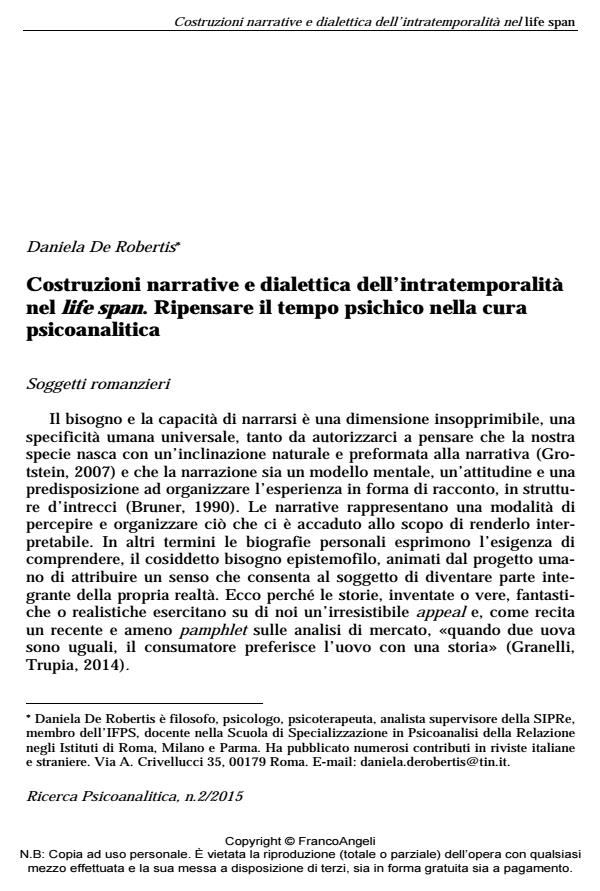Narrative constructions and dialectics of atemporality in the life span: rethinking psychic time in psychoanalytical treatment
Journal title RICERCA PSICOANALITICA
Author/s Daniela De Robertis
Publishing Year 2015 Issue 2015/2
Language Italian Pages 26 P. 19-44 File size 151 KB
DOI 10.3280/RPR2015-002003
DOI is like a bar code for intellectual property: to have more infomation
click here
Below, you can see the article first page
If you want to buy this article in PDF format, you can do it, following the instructions to buy download credits

FrancoAngeli is member of Publishers International Linking Association, Inc (PILA), a not-for-profit association which run the CrossRef service enabling links to and from online scholarly content.
The narrative model extends the opportunities for understanding the subjectivation process all along our life span. This paper discusses the act of narrating oneself in everyday life and in a clinical setting, as well as the function of narrating one’s story and the modes through which a person, consistently with her identity, builds her own life story and also how that story affects her identity. A circular causality that edits a diachronic autobiography pivoting on memories and on encoding and mnestic reactivation systems. A dynamic story, flowing and changing, subjective and personal, the product of a re-reading or reconstructing in time one’s experiences in time. But when the "film editing machine" stops and the story is read but not reread, what stops the machine and produces time gaps in inter nal time? What causes life span to go in slow motion and determines psychopathological frames? The devices of time philosophy - considering intrapsychic time as one of the possible observers - can be the toolkit that helps a clinician to frame the correlation between the perception of the internal time flow and of consciousness.
Keywords: Narrative, autobiography, subject’s story, memory, temporality, time-consciousness relation
- Autoriflessione in primo piano: il posto della parola e dell'"Attività Referenziale" Daniela De Robertis, in RICERCA PSICOANALITICA 3/2015 pp.85
DOI: 10.3280/RPR2015-003007 - Un fallimento nell’appropriazione del tempo in adolescenza: il disordine della futurizzazione Michele Valente, in Ricerca Psicoanalitica /2022
DOI: 10.4081/rp.2022.599 - Trauma e "autotrauma" nella cornice del tempo intrapsichico Daniela De Robertis, in SETTING 46/2024 pp.37
DOI: 10.3280/SET2023-046002
Daniela De Robertis, Costruzioni narrative e dialettica dell’intratemporalità nel life span. Ripensare il tempo psichico nella cura psicoanalitica in "RICERCA PSICOANALITICA" 2/2015, pp 19-44, DOI: 10.3280/RPR2015-002003